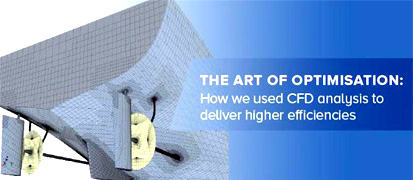THE ART OF OPTIMIZATION

For a ship meant to carry large amount of cargo at an optimum speed, operational efficiency is an imperative that can make a real difference to business. An improved hull form to reduce engine power and fuel consumption can go a long way in overall cost savings during the life of the ship. With greater operational efficiencies, it can help kick-start profitability. One of our clients posed a challenge where we needed to enhance the performance of their four Mini Bulk Carriers of 8000 dwt – without altering the carrying capacity or speed of the vessel. After strategic thinking, we approached the problem with a two pronged solution:
- optimise the hull form to reduce bare hull resistance
- improve aft body to enhance flow to the propeller, increasing propulsion efficiency
The result was a remarkably improved vessel, giving fuel saving of 4.7tons per day. Following basic engineering principle powered by high end computing power Resistance is a critical area to be considered in ship hull development. Prediction of ship resistance is often derived from experiments at model scale. The hull shape is traditionally modified until it is “manually optimised” for least resistance. In recent years, computational fluid dynamics (CFD) has enhanced the design process by predicting the flow around the hull and also the resistance. CFD uses applied mathematics, physics and computational software to visualise the flow of water and impact on the ship. Design alternatives are compared based on computed results and the best is then selected for verification. CFD cuts time and iterative effort to find the final shape. The original hull form and propulsion system was inefficient and grossly overdesigned with 2x1330kW engines. The target was to use 2x885kW engines for arriving at the design speed of 10 knots with 10% sea margin. CFD was chosen as the analysis method to optimise the hull form based on resistance.
Vedam helped design and implement an improved hull design that enabled our client to drive their business with far greater efficiency.
The first step of CFD was to simulate the existing hull and validate the results with the tank test data.


Upon running the tests, the percentage of error between CFD and experimental results were within limit, helping set a critical benchmark for future simulations.

A detailed CFD analysis revealed the following:
- Variation in LCB location: The LCB of the input hull was found to be incorrectly located for the given speed of the vessel. By shifting the LCB towards forward will greatly improve resistance. This will make the forward part bulkier but at the same time, it will allow smoother flow lines at the aft hull reducing overall resistance. This will also enable accommodating a larger propeller improving propulsive efficiency of the vessel.


- One skeg instead of two: Streamline pattern derived from bare hull analysis helped in aligning appendages. A single centre line skeg was added in lieu of two skegs ahead of propeller.
- Considering the above findings, three new hull forms were developed and checked in CFD for the optimum one. The best form was selected to further investigate with self-propulsion test to select the engine and propeller.


Vedam delivered effective results through in-depth analysis. It created improved performance across several levels.

The CFD analysis threw up critical results where effective wake fraction, thrust deduction fraction and QPC were derived, enabling us to estimate the engine selection.
- An engine power of 885 kW at 85% MCR considering 10% sea margin was sufficient to operate the vessel at 10 knots speed.
- Effective wake fraction and thrust deduction fraction were reduced by 33.67% and 57% respectively.
- QPC was improved by 32% as compared to input hull, resulting in 33% reduction in installed engine power than that of input hull.
With this aft hull optimisation exercise, the client could realise a significant savings in CAPEX and OPEX of the vessel during her life cycle. It helped re-affirm the client’s confidence on revised cargo logistic and the viability of the transportation operation.
